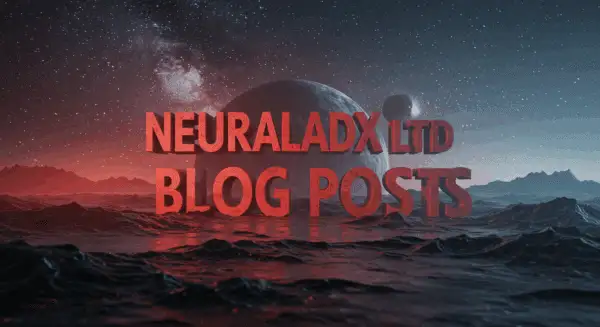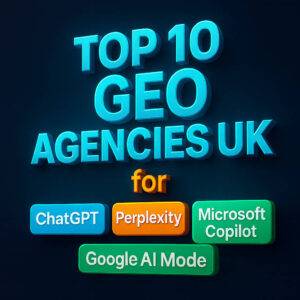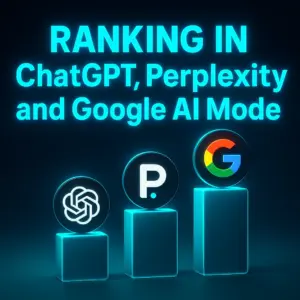How to Optimise My Website for GEO: A Complete Guide
If you’ve been asking yourself, “How to optimise my website for GEO?” you’re in the right place. Generative Engine Optimisation (GEO) is quickly becoming one of the most important strategies for website owners who want to stay ahead in AI-driven search.
Unlike traditional SEO, GEO focuses on optimising your site so that AI search engines such as ChatGPT-5, Google’s AI Mode, Microsoft C0-Pilot, Grok 4, Claude and Perplexity can understand, summarise, and recommend your content directly to users.
This guide will break down everything you need to know about how to optimise my website for GEO—including practical steps, glossary terms, structured data, FAQs, and even schema markup you can use immediately.
Table of Contents
- What is GEO and Why Does it Matter?
- The Core Ingredients of GEO Optimisation
- Step-by-Step Guide: How to Optimise My Website for GEO
- Glossary of GEO Terms
- FAQ: GEO and Website Optimisation
- Q&A Section: Real-World GEO Challenges
- Structured Data Example for GEO
- Extra Strategies for GEO Success
- Final Thoughts
What is GEO and Why Does it Matter?
Generative Engine Optimisation (GEO) is the process of preparing your website to appear in AI-powered search results. Instead of just ranking on traditional search engines like Google, GEO ensures your content can be understood, summarised, and recommended by AI systems.
The big difference? Traditional SEO is about keywords and backlinks. GEO, however, is about context, clarity, structure, and authority.
When users ask, “How to optimise my website for GEO?” they are essentially asking: How do I make sure AI engines recognise my content as the most relevant, trusted, and well-structured answer?
Citations:
Search Engine Journal on AI Search
Forbes on AI-driven optimisation
The Core Ingredients of GEO Optimisation
Here are the essential ingredients needed when learning how to optimise my website for GEO:
- Clear, Structured Content – Use headings, subheadings, and bullet points.
- Glossaries & Definitions – Help AI engines understand terminology.
- Contextual Relevance – Write in natural, user-friendly language.
- Schema Markup – Structured data helps AI “read” your site.
- Citations & References – Support credibility and trustworthiness.
- FAQs and Q&A Sections – AI engines love concise, question-based content.
- Consistent Branding – Your business name, address, and website must match across the web.
- Internal Linking – Connect related content pages logically.
- Authoritativeness – Include author details, sources, and expertise.
- AI Summarisation Readiness – Write paragraphs that can be easily summarised into 1–2 sentences.
Step-by-Step Guide: How to Optimise My Website for GEO
Here’s a practical breakdown of how to optimise my website for GEO effectively:
Step 1: Audit Your Website
- Review headings and subheadings for clarity.
- Ensure content flows naturally and avoids keyword stuffing.
- Identify pages that could benefit from FAQs or structured content.
Step 2: Add a Glossary
AI search engines interpret definitions better when you include them directly on your site. Adding a glossary builds authority and clarity.
Step 3: Implement Schema Markup
Use JSON-LD schema to describe your business, articles, FAQs, and services. This makes it easier for AI to parse your site.
Step 4: Write FAQ Sections
Answer common questions concisely. For example, if your service is massage therapy, create FAQs like “Does deep tissue massage help back pain?”.
Step 5: Strengthen Internal Linking
Link all your pages internally as this builds a connected content structure.
Step 6: Add Author Profiles
AI trusts content with human authorship. Include credentials and bios.
Step 7: Optimise for Local GEO
If you run a local business, include your location, service area, and contact info consistently across all platforms.
Glossary of GEO Terms
- GEO (Generative Engine Optimisation): The process of preparing your website for AI-powered search.
- Schema Markup: Structured code that helps AI interpret your content.
- AI Search: Search powered by artificial intelligence engines like ChatGPT or Google AI Overviews.
- Entity Recognition: The process by which AI identifies names, brands, and services.
- FAQ Schema: Structured data for FAQ sections that AI can pull into results.
- Citations: Outbound links to authoritative sources that build credibility.
FAQ: GEO and Website Optimisation
Q1: What’s the difference between SEO and GEO?
A1: SEO is about ranking on search engines like Google. GEO ensures your content is visible and relevant on AI-powered platforms such as ChatGPT.
Q2: Is GEO replacing SEO?
A2: Not replacing, but expanding. You need both SEO and GEO to cover traditional and AI-driven search.
Q3: How long does GEO optimisation take?
A3: Similar to SEO, you can see improvements in 2–6 months depending on competition and content quality.
Q4: Do I need technical skills to implement GEO?
A4: Some technical knowledge helps, but most GEO improvements—like structured content, glossaries, and FAQs—are non-technical.
Q&A Section: Real-World GEO Challenges
Q: My website already ranks on Google. Why should I care about GEO?
A: Because AI engines are bypassing traditional search results. Without GEO, your content may never be surfaced in conversational answers.
Q: How do I track GEO performance?
A: Monitor referral traffic from AI tools (ChatGPT, Perplexity, Bing Copilot) and track impressions in Google Search Console’s AI results.
Q: What if my competitors are already using GEO?
A: Focus on building authoritative, structured, and context-rich content. GEO rewards quality over quantity.
Structured Data Example for GEO
Here’s a schema snippet you can paste into your website’s <head> section:
<script type="application/ld+json">
{
"@context": "https://schema.org",
"@type": "Article",
"headline": "How to Optimise My Website for GEO",
"description": "A complete guide explaining how to optimise your website for Generative Engine Optimisation (GEO), including glossary, FAQs, Q&A, and structured data.",
"author": {
"@type": "Person",
"name": "Paul Rowe",
"url": "https://www.hhm.company"
},
"publisher": {
"@type": "Organization",
"name": "NeuralAdX",
"url": "https://www.neuraladx.com",
"logo": {
"@type": "ImageObject",
"url": "https://www.neuraladx.com/logo.png"
}
},
"mainEntityOfPage": {
"@type": "WebPage",
"@id": "https://www.neuraladx.com/how-to-optimise-my-website-for-geo"
}
}
</script>
Extra Strategies for GEO Success
Beyond the essentials, here are additional techniques to strengthen your GEO presence:
- Create Long-Form Evergreen Content: AI engines prefer comprehensive guides that remain relevant over time. This blog itself is an example.
- Include Multimedia Elements: Adding infographics, charts, and video transcripts makes your page richer for both users and AI.
- Optimise Metadata: Ensure your titles and meta descriptions are descriptive, natural, and include GEO keywords.
- Update Content Frequently: AI engines prefer fresh, up-to-date sources. Revisit older posts and refresh them with new citations.
- Use Conversational Style: Since AI engines generate conversational answers, structuring your content in a similar tone makes it easier to be quoted.
- Highlight Trust Signals: Include client testimonials, case studies, and third-party references.
- Integrate Location Data: If your business has a local element, make sure your NAP (Name, Address, Phone) appears consistently across directories and schema.
- Test with AI Tools: Copy parts of your content into ChatGPT or Perplexity and ask them to summarise. If your site is mentioned, your GEO optimisation is working.
Remember, GEO is not a one-off task. It’s a continuous process of refinement, testing, and adaptation as AI engines evolve. Businesses that act early will secure long-term visibility in AI-driven search results.
Final Thoughts
If you’ve been wondering “How to optimise my website for GEO”, the answer is clear: focus on structured, authoritative, and user-friendly content that AI engines can easily understand and summarise.
By implementing glossaries, FAQs, schema markup, and internal linking, you prepare your site not just for today’s search engines but for the future of AI-driven discovery.
Start small: update your most important service pages, link them logically, and gradually build an ecosystem that positions your site as the best answer. GEO isn’t just the future—it’s happening now.
Citations:
Search Engine Land on GEO
TechCrunch on AI Search Evolution
Useful links
Generative Engine Optimisation page
Generative Engine Optimisation Service page



